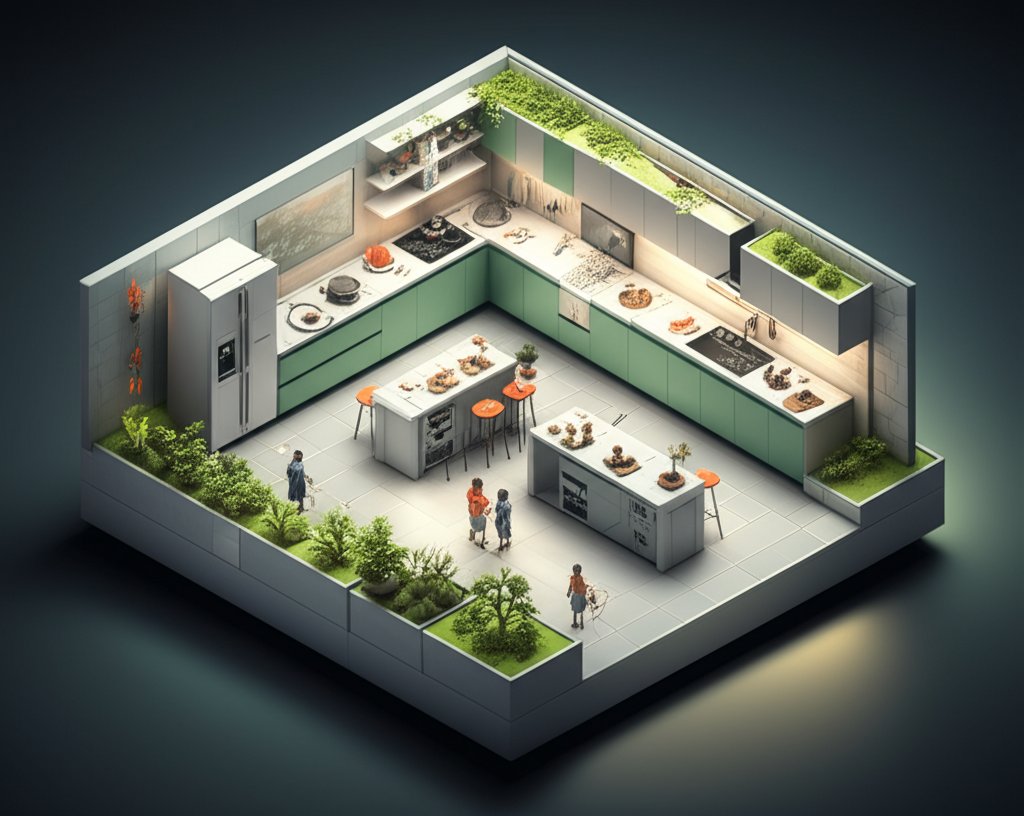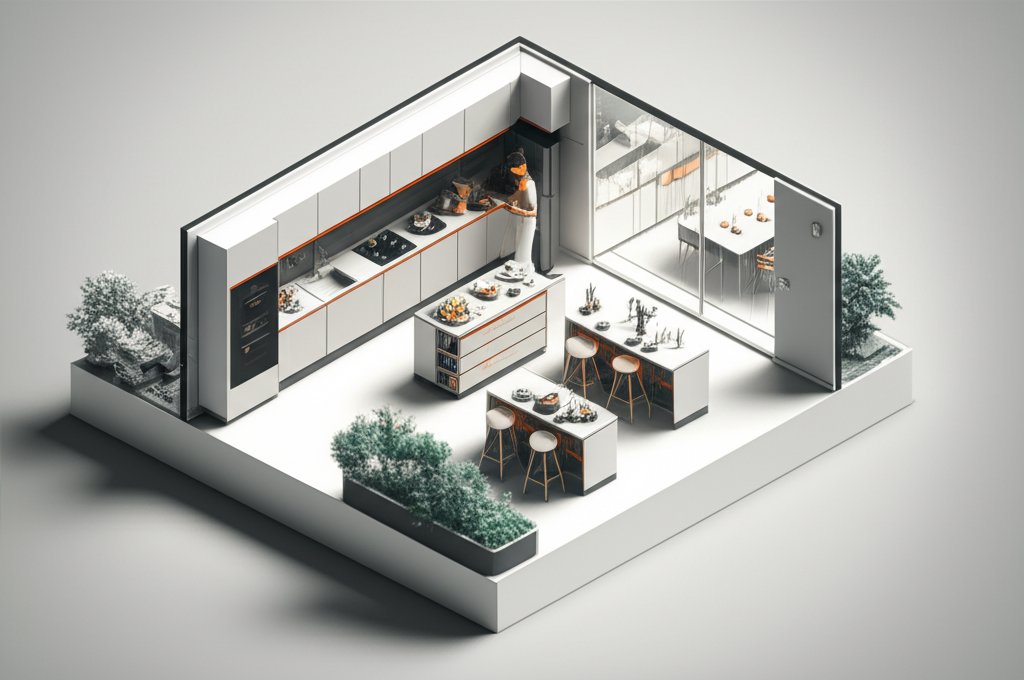Tired of bumping elbows while prepping dinner? A double kitchen island setup might be your culinary game-changer. More than just a luxury, it’s a strategic way to divide tasks, increase storage, and create a natural gathering spot.
At a glance:
- Discover how to zone your kitchen with two islands for cooking, prep, and entertaining.
- Learn key spacing considerations to avoid a cramped or awkward layout.
- Explore different island styles and how to mix materials for a unique look.
- Understand the electrical and plumbing implications of a double island design.
- Gain practical tips for maximizing storage and functionality in your double island kitchen.
Zoning Your Kitchen: The Power of Two Islands
The genius of a double kitchen island design lies in its ability to create distinct zones within your kitchen. This isn’t just about aesthetics; it’s about workflow. Imagine one island dedicated solely to food preparation – complete with a prep sink, butcher block countertop, and conveniently located knife storage. The second island transforms into a social hub, featuring bar stools, a beverage fridge, and ample space for serving appetizers. This thoughtful separation keeps the cook focused and guests entertained, without anyone feeling underfoot.
Example: A busy family with two working parents uses one island for weeknight meal prep (equipped with a speed oven) and the other as a homework station/snack bar for the kids. On weekends, the homework island converts into a buffet serving area during parties.
Spacing is Key: Avoiding the Kitchen Traffic Jam
Before falling in love with the idea of a double kitchen island, be realistic about space. Cramped aisles negate all the benefits. Experts generally recommend a minimum of 42 inches between islands and surrounding counters, but ideally, aim for 48 inches. This allows for comfortable movement, even when multiple people are working in the kitchen. Don’t forget to factor in appliance door swings (refrigerator, dishwasher) to prevent bottlenecks.
Pro Tip: Use painter’s tape to map out the island dimensions on your floor to visualize the space. Walk through common tasks (unloading groceries, cooking) to identify any potential pinch points.
Styles and Materials: Cohesive or Contrasting?

One of the joys of a double island design is the opportunity to personalize the aesthetic. You can opt for matching islands for a seamless, cohesive look. Think identical cabinetry, countertops, and hardware. Alternatively, create visual interest by mixing materials. Perhaps a dark wood island for prep paired with a light marble island for serving. This is discussed further in this guide to Double Island Kitchen Design Ideas.
Example: A modern kitchen features a sleek, white quartz island alongside a reclaimed wood island with a concrete countertop. The contrast adds character while maintaining a clean, contemporary feel.
Electrical and Plumbing Considerations: Planning Ahead
Installing a double kitchen island often requires significant electrical and plumbing work. You’ll likely need to run independent electrical lines to each island to power appliances, outlets, and lighting. If you plan to include a sink or dishwasher in one of the islands, plumbing lines will also need to be extended. It’s crucial to consult with licensed electricians and plumbers early in the design process to ensure everything is properly installed and meets code requirements.
Pitfall Alert: Skimping on electrical outlets is a common regret. Plan for plenty of outlets on both islands, including USB ports for charging devices.
Storage Solutions: Maximizing Every Square Inch

A double kitchen island offers a wealth of storage possibilities. Think beyond basic cabinets and drawers. Consider incorporating specialized storage solutions like pull-out spice racks, drawer dividers for organizing utensils, and open shelving for displaying cookbooks or decorative items. Also, consider the function of each island when planning storage. The prep island might benefit from storage for cutting boards and mixing bowls, while the serving island could include wine racks and glassware storage.
Actionable Tip: Integrate vertical storage solutions to maximize space. Tall, narrow pantry pullouts are ideal for storing canned goods and baking supplies.
Height Matters: Dual-Level Island Designs
Consider a dual-level setup to define functions. A lower countertop (around 36 inches) is ideal for food preparation, while a raised countertop (around 42 inches) works well for dining and socializing. This design allows people to comfortably sit at the island without feeling like they’re towering over the cook.
Example: One island features a standard 36-inch height for chopping and kneading dough, while the adjoining island has a 42-inch high bar top with comfortable seating for four.
Open-Concept Integration
If your kitchen flows into a living or dining area, consider how your double kitchen island can enhance the open-concept design. Use similar materials and finishes throughout the space to create a cohesive look. Consider features like open shelving or glass-front cabinets to visually connect the kitchen with the surrounding areas.
Scenario: In an open-concept loft, a double island serves as a visual divider between the kitchen and living area. Pendant lighting above the islands helps define the space while maintaining an airy feel.
The Galley Kitchen Double Island: A Streamlined Solution
Even in galley kitchens, a double kitchen island can work, albeit in a modified form. Opt for narrower islands to maintain adequate walkway space. Prioritize functionality by incorporating essential features like a prep sink and storage drawers. Consider a portable island that can be moved out of the way when not in use.
Adaptation: In a long, narrow galley kitchen, 2 smaller, rolling islands offer flexibility. They can be positioned parallel to the main counters for extra prep space or pushed together to create a temporary serving area.
Quick Answers to Common Questions
Q: Is a double island kitchen only for large spaces?
A: While a larger kitchen is ideal, creative solutions like narrower or portable islands can make it work in smaller spaces. Careful planning is crucial.
Q: Should both islands be identical in design?
A: Not necessarily. You can create a more dynamic look by varying materials, finishes, and heights. However, maintain a consistent style to ensure cohesion.
Q: What is the ideal distance between the two islands?
A: Aim for at least 42 inches, but preferably 48 inches, to allow for comfortable movement.
Q: How do I light a double island kitchen effectively?
A: Use a combination of ambient, task, and accent lighting. Pendant lights above the islands provide task lighting, while recessed lighting and under-cabinet lighting enhance overall brightness.
Q: What’s the best countertop material for a double island?
A: This depends on your budget and lifestyle. Quartz, granite, and marble are popular choices, but consider factors like durability, stain resistance, and maintenance.
Practical Playbook: Your Double Island Decision Tree
- Assess Your Space: Measure your kitchen and sketch out a rough layout.
- Define Your Needs: Determine how you’ll use each island (prep, cooking, serving, dining).
- Consider Your Style: Choose a design aesthetic that complements your home.
- Plan Your Layout: Experiment with different island configurations (parallel, perpendicular, staggered).
- Factor in Functionality: Incorporate features like sinks, appliances, and storage solutions.
- Consult Professionals: Work with an architect, designer, and contractor to bring your vision to life.
- Budget Realistically: Account for all costs, including materials, labor, and appliances.
Your Next Step
A double kitchen island is a significant investment, but the rewards – increased functionality, enhanced aesthetics, and a more social cooking space – can be well worth the cost. Start by carefully assessing your needs and space, and then work with professionals to create a design that truly reflects your lifestyle.
- Glass On Tile: A Stylish Kitchen Backsplash Option - December 1, 2025
- Glass Tiles for Kitchen: Style and Durability Tips - November 30, 2025
- Decorative Wall Tiles for Kitchen: Stylish Design Ideas - November 29, 2025










